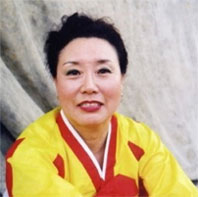- Bongsan Mask Dance
- Gungsijang
- Bupyeong Dure-nori
- Gaetganorae (Sea Shore Song) and Baennorae (Boating Song)
Bongsan Mask Dance
Kim Ae Sun

- October 11, 1937
- Jugong APT 102-1002 412 Elsin-dong
- designated on December 1, 1989
- National Designation Number 17n
Bongsan Mask Dance has been practiced in Gilyangri Dongsunmyun Bongsangun Hwanghaedo for about 200 years ago. With the transfer of administrative institutions such as Bongsangun District Office which moved to Sariwon in 1915 and the opening of Gyeongewi railway, the mask dance also moved to Sariwon and was practiced on the hill of Gyeongahm Mountain. As a part of seasonal tradition, Bongsan Mask Dance originated as the people set a bonfire and danced overnight on Gyeongahm square in front of Gyeongahm Mountain every Danoh in May. It is regarded as the most popular Haeseo Mask Dance that was widely practiced in Hwanghaedo area, and it is interpreted as a sect of Sandodaegamgyetongguk because of the exaggeration and content of scenario. Bongsan Mask Dance was revived by a person named Ahn Cho Mok, who was an official of Bongsangun 200 years ago. He was exiled on an island in Jeolado. Upon his return from exile, he significantly influenced the dance by changing the clay-made mask into a paper-made mask. Bongsan Mask Dance was connected to the area of Shindaenori in the south, and it was constantly upgraded with the influence of the mask dance of other areas. Notably, Bongsan Mask Dance was strong in its characteristic as Beoksa (exorcism of noisy ghost). Currently, the entertainment element involved in the mask dance is becoming more predominant than its religious element.
Structure of Bongsan Mask Dance
- Musical Instruments include 3 strings and 6 horns such as pipe, jutdae, drum, janggu, haegum. The main dance is performed with yumbul, tarung and gutgeori. Basically, it is a mask dance play that includes gestures, movements, talks, songs and other artistic elements. Being as such, it can be divided into a dance part and a play part. It can worth noting that the structure of performance consists of seven stages.
- Sasangzah Dance
- Palmokjung Dance
- Sadang Dance
- Nojang Dance (Apostate Monk Dance, Shoemaker Dance, Chuibari Dance)
- Lion Dance
- Nobleman Maltugi Dance
- Miyal Grandmother Dance
Artist Designation
With its leader, Kim Jin Ok, the father of Kim Ae Sun, Bongsan Mask Dance was designated as intangible cultural assets number 17 on June 17, 1967. Kim Jin Ok died 2 years later, and his son, Kim Ae Sun, was recognized for succeeding her father's career. in 1989, Kim Ae Sun was designated as an artist by the role of Mokjung, Sangzah and Somu. At her age of 53, she became the youngest among 5 artists of number 17 intangible cultural assets.
자료관리 담당자
- 담당부서 : 환경보전과
- 담당팀 : 오수관리팀
- 전화 :